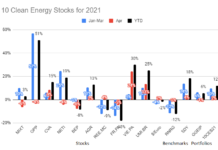Tom Konrad CFA
 Last week, when Lime Energy (NASD:LIME) announced that an internal investigation by its audit committee had revealed up to $15 million in misreported revenue, my first instinct was to sell, especially because the misreported revenue included not only revenue assigned to the wrong period, but possibly completely fictitious revenue.
Last week, when Lime Energy (NASD:LIME) announced that an internal investigation by its audit committee had revealed up to $15 million in misreported revenue, my first instinct was to sell, especially because the misreported revenue included not only revenue assigned to the wrong period, but possibly completely fictitious revenue.
Whenever a company reveals accounting problems, it’s bad. But there are levels of bad. As Garvin Jabusch, Cofounder and CIO of Green Alpha Advisors and manager of the Sierra Club Green Alpha Portfolio put it,
“The revelation that the company may have recorded “non-existent revenue” is a major concern. Somewhat less concerning is “Revenue being reported earlier than it should have been,” which is a violation of the matching principle, and is a relatively easy mistake to make and can be readily forgiven if properly restated. But the term “non-existent revenue” is a major red flag… There are only a couple of reasons phantom revenue could get booked, and most firms have controls in place to make sure that sources of revenue are verified before they’re booked. So at the very least, we can say that there are material weaknesses in LIME’s internal controls. At worst, some relatively senior person may have misinformed the accounting team. ”
The stock had closed (after a suspicious day-end decline) at $2.03 the day before, so I put in limit orders to sell my entire position at $1.75 when the market opened. LIME opened at $0.83, which I found shocking because the announcement also said, “[The company] currently believe[s] that the cumulative adjustment to revenue for the affected financial statements will not exceed $15 million.”
I took this statement as an extremely positive sign. When there are known accounting irregularities, usually all bets are off, and executives know that shareholder lawsuits are going to follow in short order (at least eleven such lawsuits have already been filed.) For company and executives and the board, the risks of making a statement like “adjustment to revenue… will not exceed $15 million” are large, and one sided. If they are wrong about the $15 million, there are guaranteed to be additional lawsuits, and, unlike the original accounting problems, they will not be able to say “we had no idea there was anything untoward going on.” So Lime’s board is confident that the scope of the accounting problems is limited, and does not affect the entire company’s books.
Since the $15 million in question is small (Lime’s revenues over the two and a quarter year period were $233 million,) the board audit committee is saying that the problem is isolated to a small part of the company, possibly a single, lower level employee. This is still bad for management, and particularly the CFO, Jeffry Mistarz, who should have had a system in place to verify all sales. But it should not put the existence of company at risk, which is why I think the current $0.90 price of the stock is way too low, and why I wrote that any price below $1.25 not only conservatively values the stock, but leaves an ample safety margin to account for the current uncertainty.
To add further evidence that the accounting problems were very limited in scope, senior management and board members were all acquiring the stock, often in large quantities, for the entire period that the accounting problems were taking place. Not only was Mistarz buying and holding on to all his incentive stock awards, but the former chairman of the board, David Asplund, whose departure from the board for “health reasons” in June raised the suspicions of some observers, also made purchases of the stock shortly before he left his job as CEO, and in March, shortly before his June departure as chairman. It seems unlikely to me that any of these share purchases would have been made if Mistarz or Asplund had been aware of the accounting problems.
 |
| Lime or Lemon? photo via Bigstock |
Making Limeade
In short, while it makes sense “to avoid corporate drama that involves unexpected resignations and unscheduled week-end board meetings,” as Debra Fiakas put it, I disagree with Jabusch when he says, “until these accounting concerns are addressed – which for us means a thorough review by an auditor not previously associated with the firm and clear corrective measures of whatever the underlying problem turns out to be – we aren’t interested at any price.”
In my opinion, there is strong reason to believe that the accounting problems at Lime Energy are limited in scope, both because of the $15 million limit mentioned (6.4% of revenue over the relevant period in question), and because of the buying of stock by company insiders. Lime’s audit committee will put out a full report on the accounting problems in when they have completed their review, quite possibly with the help of an independent auditor, as Jabusch suggests. If that report shows that the improper accounting was as limited in scope as I believe, the stock will rally strongly. If only half of the losses associated with the current uncertainty are recouped, investors who buy the stock at toady’s $0.90 price, will see an immediate gain of 74%.
That gain needs to be compared to the downside risk that the accounting problems are pervasive, and the whole company is a Ponzi scheme, and Enron writ small. But Enron’s CFO Andrew Fastow sold 687,445 Enron shares, worth $33.7 million in the three years leading up to the scandal. He wasn’t buying, like Lime’s Mistarz. Even if the problems are more pervasive that I think, the company should at least be able to be liquidated for something resembling its tangible book value of about $1 a share.
With the stock already below $0.90, even a liquidation should not result in catastrophic losses to investors buying now. Despite this, the current lack of information is forcing many professional money managers like Jabusch to stay away. Due to the higher standards of caution usually employed when managing client funds, Jabush says he has “no business exposing clients to companies where there is real, public possibility of accounting shenanigans,” even though he “would consider buying LIME at this point for a personal account, being fully aware of the risks.”
When there is more information out about what has been going on with Lime’s books, the return of such cautious money has the potential to quickly boost the stock price.
Disclosure: Long LIME
DISCLAIMER: Past performance is not a guarantee or a reliable indicator of future results. This article contains the current opinions of the author and such opinions are subject to change without notice. This article has been distributed for informational purposes only. Forecasts, estimates, and certain information contained herein should not be considered as investment advice or a recommendation of any particular security, strategy or investment product. Information contained herein has been obtained from sources believed to be reliable, but not guaranteed.








